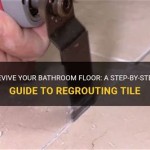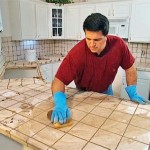How To Remove Floor Tiles In Bathroom: A Comprehensive Guide
Removing floor tiles in a bathroom can be a challenging but achievable task for a homeowner looking to renovate or repair their space. Proper preparation, the right tools, and a systematic approach are crucial for a successful and damage-free removal. This article provides a detailed guide on how to remove bathroom floor tiles, outlining the necessary steps from initial assessment to cleanup.
Before undertaking any tile removal project, it is important to assess the existing conditions. Understanding the type of tile, the adhesive used, and the subfloor material will influence the removal strategy and the tools required. Safety precautions are paramount to prevent injury and minimize dust exposure. Patience and persistence are key, as tile removal can be a time-consuming process.
1. Preparation and Safety Measures
Prior to commencing the tile removal process, thorough preparation is essential. This involves gathering the necessary tools, clearing the bathroom space, and implementing safety measures to protect oneself and the surrounding environment. The following steps outline the preparatory phase:
Gathering Tools and Materials: A well-equipped toolkit is crucial for efficient tile removal. Essential tools include a hammer, a chisel (preferably a cold chisel and a smaller detail chisel), a pry bar, a putty knife or scraper, safety glasses, work gloves, knee pads, a dust mask or respirator, and a utility knife. A vacuum cleaner, trash bags, and a drop cloth are also necessary for cleanup and containment.
Clearing the Bathroom Space: Remove all movable objects from the bathroom, including rugs, toiletries, and any freestanding furniture. Cover any remaining fixtures, such as the toilet and vanity, with drop cloths to protect them from dust and debris. Consider removing the toilet entirely if it is located near the tiles being removed to provide ample workspace and prevent accidental damage.
Implementing Safety Measures: Safety should be the foremost concern throughout the tile removal process. Always wear safety glasses to protect the eyes from flying debris. Work gloves will protect the hands from cuts and abrasions. Knee pads will provide cushioning and support while working close to the floor. A dust mask or respirator is essential to prevent inhaling dust and potentially harmful particles, especially if the tile or grout contains asbestos (in older homes).
Assessing the Tile and Grout: Before starting, examine the type of tile and grout. Ceramic and porcelain tiles tend to be more brittle and may shatter more easily. Stone tiles, such as marble or granite, can be more durable. The type of grout used can also affect the ease of removal. Cement-based grouts are typically harder to remove than epoxy-based grouts. If in doubt about the age of the tiles and grout, and the possibility of asbestos, it is advisable to have samples tested by a qualified professional.
Determining the Subfloor Material: Identifying the material beneath the tiles will help determine the appropriate removal technique. Common subfloor materials include concrete, plywood, and cement backer board. Concrete subfloors can withstand more aggressive removal methods, while plywood subfloors require more careful approaches to avoid damage. Understanding the subfloor composition will also inform the selection of appropriate underlayment and adhesive for the new flooring.
2. The Tile Removal Process
With the preparation complete, the tile removal process itself can begin. A systematic approach is crucial to minimize damage to the subfloor and ensure a clean and efficient removal. The following steps outline the tile removal process:
Softening the Grout: Before attempting to remove the tiles, soften the grout to weaken its bond. Apply a grout softening solution, available at most hardware stores, to the grout lines. Allow the solution to sit for the recommended time, typically 15-30 minutes. Alternatively, a steam cleaner can be used to soften the grout. The steam will help to loosen the grout and make it easier to remove.
Removing the Grout: Once the grout has been softened, use a grout removal tool to remove as much grout as possible. A grout saw or a rotary tool with a grout removal attachment can be used for this purpose. Apply steady pressure and move the tool along the grout lines, being careful not to damage the surrounding tiles or the subfloor. Remove as much grout as possible to create space for lifting the tiles.
Lifting the First Tile: The first tile is often the most difficult to remove. Begin by using a hammer and chisel to create a starting point. Place the chisel at an angle against the edge of the tile and tap it firmly with the hammer. Work around the perimeter of the tile, gradually loosening the adhesive bond. If the tile is particularly stubborn, try using a heat gun to soften the adhesive. Apply heat evenly to the tile and grout lines, being careful not to overheat the tile or subfloor.
Prying the Tiles Loose: Once a starting point has been established, use a pry bar or putty knife to carefully pry the tile loose from the subfloor. Insert the pry bar or putty knife between the tile and the subfloor, and gently apply pressure. Work around the tile, gradually lifting it from the subfloor. If the tile is breaking into pieces, use a hammer and chisel to carefully remove the remaining fragments.
Dealing with Stubborn Tiles: Some tiles may be more difficult to remove than others due to a stronger adhesive bond or irregularities in the subfloor. For stubborn tiles, try using a reciprocating saw with a metal-cutting blade to cut through the adhesive. Insert the blade between the tile and the subfloor, and carefully cut along the perimeter of the tile. Alternatively, a multi-tool with a scraper attachment can be used to scrape away the adhesive.
3. Subfloor Preparation and Cleanup
After the tiles have been removed, the subfloor must be properly prepared for the new flooring. This involves removing any remaining adhesive, leveling the surface, and ensuring a clean and stable foundation. The following steps outline the subfloor preparation and cleanup process:
Removing Adhesive Residue: After the tiles are removed, adhesive residue will likely remain on the subfloor. Scrape away any loose adhesive with a putty knife or scraper. For stubborn adhesive, use a chemical adhesive remover, following the manufacturer's instructions carefully. Apply the remover to the adhesive residue and allow it to sit for the recommended time. Then, scrape away the softened adhesive with a putty knife or scraper. Always wear gloves and a respirator when using chemical adhesive removers.
Leveling the Subfloor: A level subfloor is essential for a professional-looking flooring installation. Use a level to identify any high or low spots in the subfloor. For high spots, use a grinder or sander to smooth them down. For low spots, apply a self-leveling compound, following the manufacturer's instructions carefully. Pour the self-leveling compound onto the low spots and spread it evenly with a trowel. Allow the compound to dry completely before proceeding.
Cleaning the Subfloor: Thoroughly clean the subfloor to remove any dust and debris. Vacuum the entire surface to remove loose particles. Then, wipe down the subfloor with a damp cloth to remove any remaining residue. Allow the subfloor to dry completely before installing the new flooring. A clean and dry subfloor will ensure a strong bond between the subfloor and the new flooring.
Disposing of Tile and Debris: Properly dispose of the removed tiles and debris. Broken tiles can be sharp and hazardous, so handle them with care. Place the tiles and debris in heavy-duty trash bags and seal them securely. Contact your local waste management service to inquire about proper disposal methods. Some areas may have specific regulations for disposing of construction debris. Consider renting a dumpster for larger projects to simplify the disposal process.
Inspecting the Subfloor: After cleaning, thoroughly inspect the subfloor for any signs of damage, such as cracks, holes, or rot. Repair any damage before installing the new flooring. Cracks can be filled with epoxy filler. Holes can be patched with plywood or cement backer board. Rot can be treated with a wood preservative or, in severe cases, the affected area may need to be replaced. A sound and stable subfloor is essential for a long-lasting flooring installation.
Applying a Primer (Optional): Depending on the type of subfloor and the adhesive being used for the new flooring, a primer may be necessary. A primer will help to improve the adhesion between the subfloor and the adhesive. Choose a primer that is compatible with both the subfloor material and the adhesive. Apply the primer evenly to the subfloor with a paint roller or brush, following the manufacturer's instructions carefully. Allow the primer to dry completely before installing the new flooring.
Removing bathroom floor tiles requires careful planning, execution, and cleanup. By following these guidelines and prioritizing safety, homeowners can successfully remove old tiles and prepare their bathroom for a fresh new look. Remember to consult with professionals if you are unsure about any aspect of the process, especially when dealing with potentially hazardous materials like asbestos.

How To Remove A Tile Floor

How To Remove Floor Tile Tips S And Tricks

How To Remove A Tile Floor

3 Easy Ways To Remove Ceramic Tile Wikihow

How To Remove Old Tiles A Step By Guide Walls And Floors

How To Remove Tile Diy Easy Ceramic Removal

Remove Floor Tile Effectively With Rubi S Tools And Tips

How To Remove Tile Ugh The Honeycomb Home

How To Remove Tile An Easy Diy Guide Dumpsters Com

How To Remove Tile Floor A Diy Guide
Related Posts








